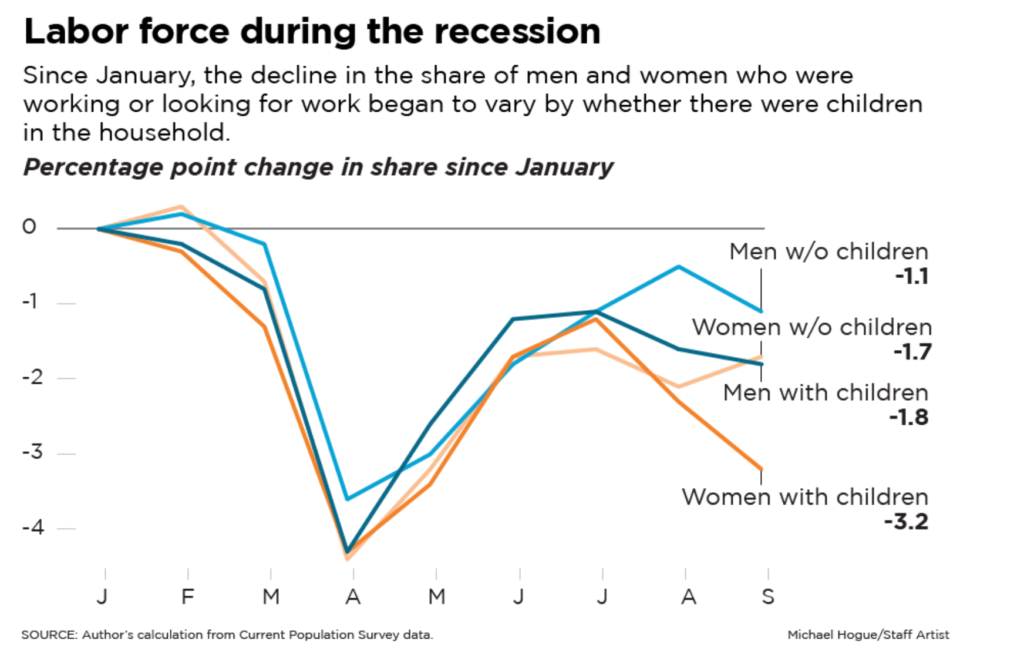A: Women are currently leaving the labor force at higher rates than men. Mothers account for the starkest declines. To quote social scientists Drs. Kerri Raissian and Jennifer Dineen: “We need to realize that mothers can’t continue to be our shock absorbers.”
Context:
The steep relative decline in female labor participation – most pronounced among moms – is hitting a raw collective nerve. Your Nerdy Girls (most of whom are working moms) are here to shed light on the related stats. And we do so keeping the shared sacrifices of all family caregivers top-of-mind…..because in the words of sociologist Dr. Kate Averett “all the choices stink.”
Friendly heads-up: Thanks for your patience with this long post – the author (Nerdy Girl Lindsey) was trained by labor economists and is admittedly overly fond of labor force data. We’ve added TL;DR emoji bullet points to enhance the post’s “skim value” 😀
FIRST: JUST THE FACTS, MA’AM
What, exactly, is “labor force participation (LFP)?” Here’s an approximate equation:
📣 Labor force participants = Workers + Non-workers actively seeking work
Note that LFP includes both the employed **and** the unemployed – those who aren’t working but are proactively looking for work. Dropping out of the labor force is akin to “sitting it out,” doing neither. For our fellow hard-core nerds seeking greater technical detail, we’ve provided related references below. And stay tuned for future posts specifically tackling unemployment.
Economist Kathryn A. Edwards of the highly respected think-tank RAND corp. crunched recent months’ LFP numbers using the Bureau of Labor Statistics’ Current Population Survey Data. The resulting timeline:
🗓️ April 2020: LFP dropped sharply for both men and women.
🗓️ Early Summer 2020: LFP levels stabilized (but not did not completely recover), again trending similarly for men and women.
🗓️ August/September 2020: LFP trend lines for parents started diverging from non-parents. Moms experienced the sharpest drop. (Technical definition of “parent” in references).
🗓️ October 2020: Total LFP among women down by 2.2 million year-over-year, reflecting a 3% drop. Benchmark: Total LFP among men down by 1.3 million year-over-year, reflecting a 1.5% drop.*
Underlying calculations: Women’s LFP down from 74.5 million in Oct. 2019 to 72.3 million in Oct. 2020, a decrease of 2.2 million, representing a 3% drop from Oct. 2019 baseline level. Benchmark: Men’s LFP down from 83.9 million in Oct. 2019 to 82.6 million in Oct. 2020, a decrease of 1.3 million, representing a 1.5% drop from Oct. 2019 baseline level.
SECOND: HONORING SHARED SACRIFICES BY ALL FAMILY CAREGIVERS
As data geeks, we are the first to admit that population-averages often belie the varied situations of individual households. In that spirit, we offer up two final thoughts:
➡️ Make no mistake: Men aren’t getting a free pass during this pandemic.
Many are now shouldering the pressure of bringing home the solo income in the household. Many remain unemployed. And others have sidelined their own earning power to serve as their household’s caregiving “shock absorber” (See references below for the related evidence).
➡️ We celebrate ALL caregivers
For those who have happily chosen to forego paid employment for family caregiving: We celebrate you. For those who were forced to stay home: We see you. For those who would prefer to stay home but can’t: We see you, too. For our fellow working moms: Solidarity. For single parents: Sending you a big heroes salute. For blended families and other family caregivers: We honor your steadfast grace, strength, and selflessness. And for those who fall into a complex combination of the preceding categories: We lift you up. Simply put, we have deep respect for ALL of the family caregivers in the Dear Pandemic community. Caregiving is no-joke hard, even in the best of times.
And these are definitely not the best of times.
With love,
Your Nerdy Girls
References (in chronological order):
Drs. Raissian and Dineen – quoted from their excellent piece in The Hill
Dr. Kate Averett – quoted via the NYTimes
Bureau of Labor Statistics’ definition of labor force participation. (Warning: Not for the faint of heart! Get ready for some hard-core labor economics nitty-gritty 😀)
Dr. Edwards’ data, as reported via the Dallas Morning News
“Parent” defined as having a child age 0-17 in the household
*Calculations by Nerdy Girl Lindsey using data from this recent Bureau of Labor Statistics news release
Men dealing with stressors of solo breadwinning, unemployment and being the household “shock absorber”:

Image credit: Dr. Kathryn A. Edwards’ calculations in the Dallas Morning News


